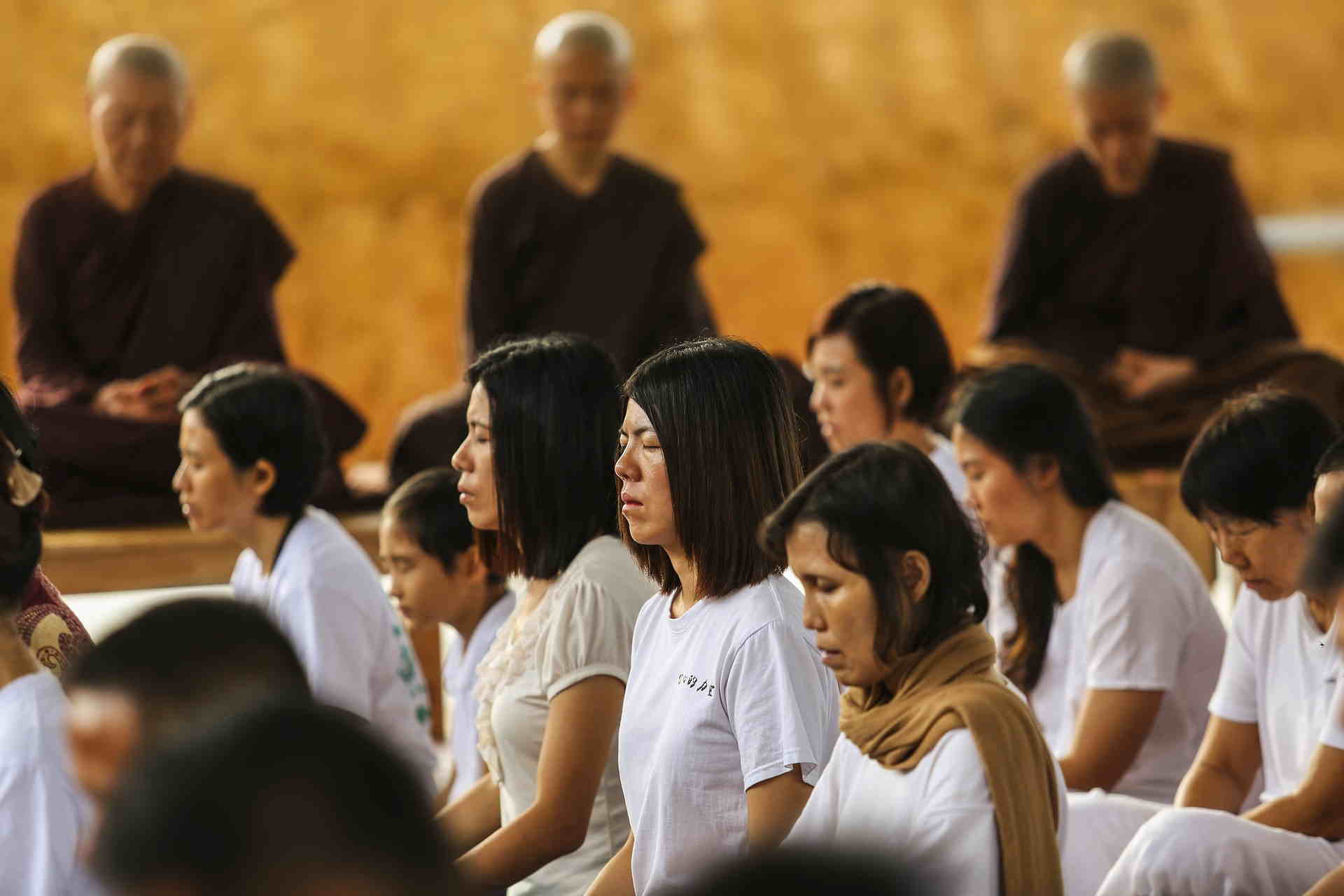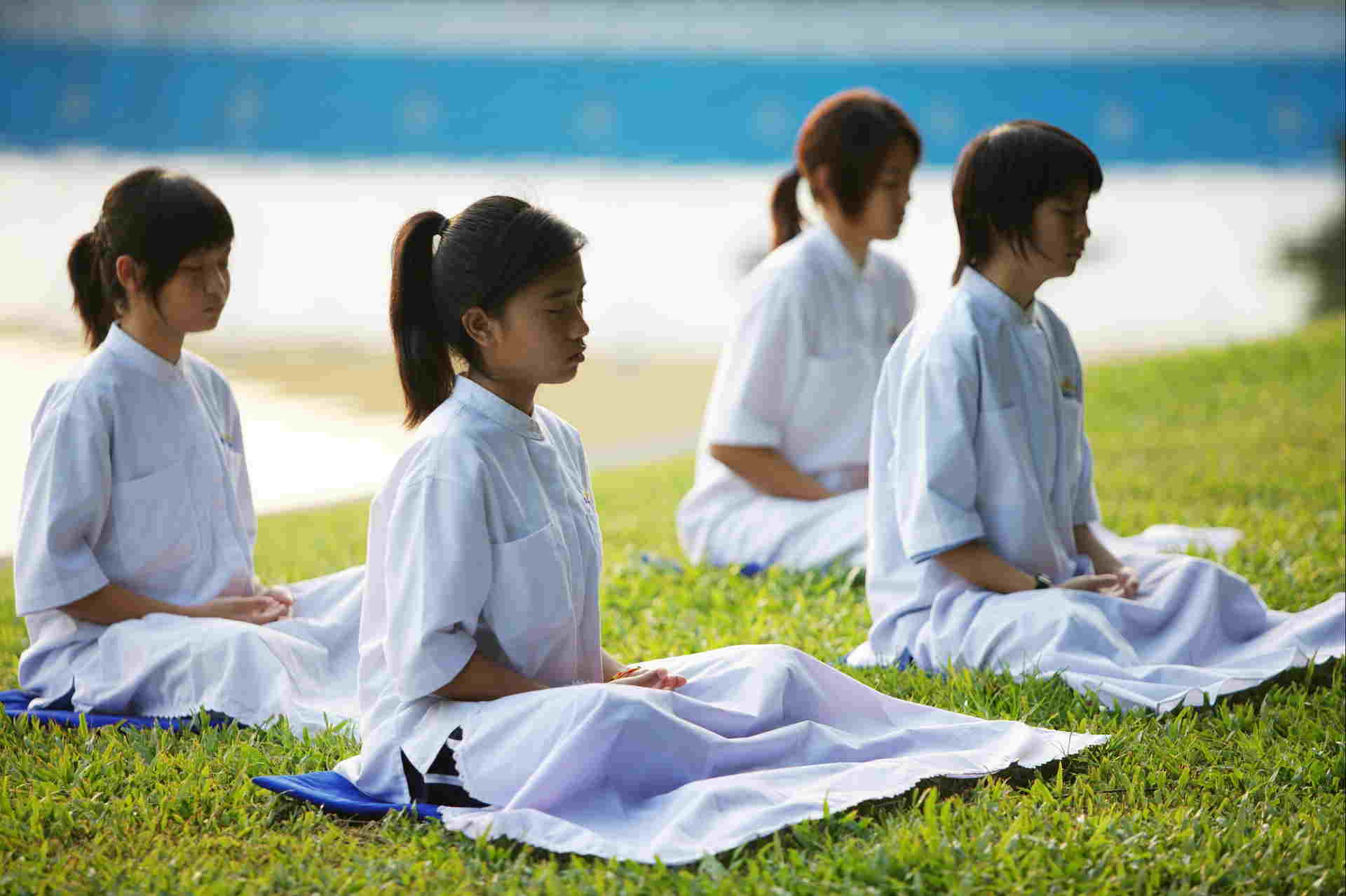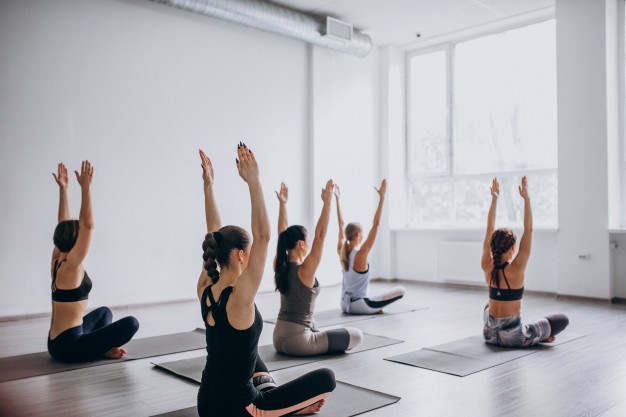Meditation is very important for performance and improving students’ attention, grades & concentration. So many schools and teachers have now decided to bring Guided Daily Meditation to their classrooms, through various ways to help students benefit from them.
Jerry Lawson, one of the teachers who uses the Guided Meditation for Students Script at the Springbook Elementary School in Rhode Island says: “it’s truly amazing to see that these really tuned kids relaxing and ignoring the outside world for a minute.”
Professor Jerry Lawson performs this task every day with students. Turn off the lights, students become comfortable and begin the Guided Meditation for Students Script.
Although we may think that the life of children lacks the stress of that of adults. However, they are under great pressure that we can go unnoticed at times. Homework, exams, problems at home or relationships with peers can cause children and young people to develop stress and not know how to deal with it, if we don’t teach them.
The American Psychological Association conducted a survey in 2013 of young students and almost half of them said they did not do enough to control their daily stress.
Benefits of Student Meditation – Does Guided Meditation help?

Herein, I would like to share the results obtained from a group of 200 students who underwent a scientific study with meditation at the Maharishi University of Administration, in California, United States and another group of students with which they would compare the final results of both groups; being both groups at the beginning in equal academic conditions.
1. Increased Intelligence: Scientific studies showed that students who practiced meditation after three months their Intellectual Co-efficiency had increased in areas of creativity and practical intelligence related to better processing of things.
Research shows that meditation increases cortical thickness especially in areas related to introspection and attention as well as increasing gray matter, related to memory and thinking.
2. Academic Performance: Students participating in the study obtained an improvement in academic areas such as mathematics and languages, compared to the group of students who did not meditate; they improved their grades by 40%.
3. Drug Reduction: Students undergoing study and who practiced meditation reduced the use of alcoholic beverages, psychoactive substances, even medicines and meditation for students was an excellent tool for the development of psychoactive substance prevention programs.
4. Better Brain Performance and Efficiency: it was noted that students participating in the study increased all their abilities as well as greater self-control.
5. Stress Reduction: The group of students which practiced meditation noticed having a better emotional and physical behavior, acting calmly in the face of complex situations related to academic life.
As well as tolerance for unfavorable situations and a better analysis of the challenges to be solved.
6. Decrease of heart disease: Due to the technique of relaxation and breathing control it was shown that meditation helps reduce blood pressure including in people suffering from hypertension, helping those who do not suffer in reducing the potential suffer from hypertension in 52%.
7. More Security: Students who practiced meditation demonstrated more security in all social fields, as well as better emotional behavior, feeling in control at every moment.
7 Short Guided Meditations for Students Script
Meditation indeed is a powerful tool to relax the mind and reduce stress. Herein, I would like to offer you 7 Written (Short) Guided Meditations for Students Script for Concentration that you can use daily for / with your students / kids.
1. How do you meditate as a Student? (for Concentration) – Script 1
Over the next 7 Short Guided Meditations for Students Script (for Concentration) Sessions you will learn some very simple meditation techniques to calm and relax your mind.
You just have to follow the written instructions that I will give you step by step. You will soon see that meditation is a faculty that we all possess and can train.
To learn to appease the coming and going of thoughts, just meditate a few minutes each day. Regularity in practice is essential to develop this quality of inner peace.
Well, let’s start now with the first meditation session for students for concentration.
- Find a quiet place and make sure you are not going to be interrupted by your mobile, by people or by anyone around you.
- Sit in a chair or on the floor with your back straight but relaxed. If you sit on the floor, do it on a cushion to be more comfortable.
- Now take three deep breaths. Breathe through your nose and exhale through your mouth. This will help you relax.
- And now you can gently close your eyes. Try to let your breath flow in its natural state.
- It allows inspiration and exhalation, little by little, to be accompanied at its normal pace, without pressure, without blockages, without ties.
- Let yourself go. Rest in the breath. And from this state of relaxation, focus your attention on breathing.
- Just watch the air come in when you inhale and notice the air goes out when you exhale. The air enters, the air goes out, enters, goes out… Need to only watch it, notice it, that’s it – it’s that simple.
- It is possible that some thoughts may distract your attention. It is normal. Don’t panic. When this happens, without getting angry, kindly and gently, return your attention to the breath again.
- In this process of air entering and leaving, your body expands with each inspiration, your body relaxes with each exhalation… and if another thought comes, again, rest your attention on the pleasant sensation of breathing… and so on for a few seconds.
- Now you can reconnect with your body, with the sounds around you. And whenever you want, you can open your eyes – Slowly.
Now observe for a moment in what state your body and mind have remained.
Perhaps more relaxed? Nothing happens if you have had many thoughts today and it has been difficult to appease your mind. It happens, it is natural – you don’t have to worry about it.
Today is the first day. Now let’s continue moving forward to the next Short Guided Meditation for Students Script for Concentration Session.
Read: 5 Minute Meditation for Students (Guided Meditation to Improve Grades)
2. How Meditation is useful for Students? – Script 2
In the “How do you meditate as a Student? – Script 1″ you practiced your first meditation. Some people find it a bit more difficult, while for others it is surprisingly easy to get acquainted with the fact of resting attention on breathing.
Keep in mind that you are learning a new technique or skill, which is always a bit difficult at first.
However, you will soon see that, with a daily practice, little by little, it will be easier for you. The attention is like a muscle.
It requires training to be able to exercise a greater level of control and help you focus, stay still.
- With this in mind, sit comfortably with a firm but relaxed back.
- Now take a deep breath. Breathe through your mouth and exhale through your nose.
- As you relax, close your eyes slowly. The hands rest on the thighs and you notice the contact of the feet with the ground.
- Now look at the sounds around you, just as you watch your thoughts come and go. Observe them without judging them, without getting hooked on them… just observe how they are.
- Maybe lazy, distant or close, maybe serious or acute, known or unknown…
- Now turn your attention to the breath. Gradually observe with curiosity how is your natural breath, without forcing.
- Maybe it’s long and deep, or short and shallow. It is always here, but we almost never look at it. Look closely, how is your breathing right now?
- Now you can turn your attention back to the sensation of body contact, the sounds around you and slowly you can open your eyes.
In the same way as we did in Script 1 Session, notice how your body feels after having practiced this exercise.
Remember that meditation is not about eliminating thoughts, but that it helps us to better understand how they work and allows us to live with them healthier.
Read: 2 Minute Meditation for Beginners (6 Simple Techniques to Meditate)

3. Short Guided Meditation for Students – Script 3
There are many ways to meditate and all of them teach us to understand our mind, so that we learn to slow it down, calm it down and reassure it… so that we can enjoy the experience of the present moment more.
Remember; that instead of eliminating thoughts, we just want to observe them when they come.
We just want to realize when a thought arrives, without getting angry, without rejecting it, without getting attached to it, without holding them down and without judging whether it is right or wrong… the exercise consists in simply observing them, as if they were like clouds in the sky.
Clouds that come and go. Thoughts that come and go, – they just simply come and go.
- When you’re ready, let go of the worries you’ve accumulated today and sit comfortably, with your back straight, your shoulders relaxed, your hands resting on your lap or knees… and take a deep breath, breathe in through your nose and exhale through the mouth.
- While you relax you close your eyes slowly. Feeling the weight of the body. Look at the sounds around you… and see if your body feels agile or tired.
- Start feeling the movement of the breath in your body.
- Look curiously on which part of the body you feel the breath. Maybe in the nose, in the belly or maybe in the chest.
- And see what your breathing is like. Long or short, big or small. Let your attention rest in this breathing movement. Do not try to change it, you just need to notice it.
- When a thought comes, observe it as if it were a cloud in the sky. A thought that comes, is a thought that leaves.
- Allow it to exist, to approach and with kindness, gently, allow it to move away and disappear.
- And return your attention back to the breath again – unforced and naturally. And stay here, very still, a few more seconds…
- Now turn your attention back to the body, the feeling of contact with the floor, the sounds you can hear from the room or wherever you are, maybe you can notice some odors and now slowly open your eyes.
Take a moment to observe how you feel. Are you the same as ten minutes ago? It is not about judging, if not realizing.
Remember that in this exercise it doesn’t matter how many clouds there are in the sky, what size they are or what color they are. What interests us is to see how we relate to clouds, how we relate to thoughts and treat them.
Read: How to Practice Hong-Sau Technique of Concentration (Guided Meditation)
4. Short Guided Meditation for Students – Script 4
As you could see in Short Guided Meditation for Students – Script 3, observing the cloud traffic in the sky, it is very tempting to react to one of them.
If you see a cloud that you like, you may have the urge to stick to it, to enjoy it.
However, if you see a cloud – or a thought – ugly or unpleasant, you will want to fight it or run away.
This is a totally normal behavior and as you become more familiar with the practice of meditation, it will be easier for you to observe the thoughts without judging or reacting to them and returning to the breath again. And so over and over again.
- With this in mind, sit back and relax. And take a deep breath. Breathing through the mouth and exhaling through the nose.
- You relax and when you’re ready, close your eyes slowly.
- Realizing the space and the sounds around you, the weight of your body with the ground, noticing the general feeling of the body, of heaviness or lightness, maybe there is some area of the body that you can notice more easily.
- You may notice discomfort, pain, tingling… and at the same time become aware of the breath, the movement of the air in and out. Watching how the body breathes.
- Observing with curiosity how breathing is and in what part of the body you can recognize it more easily.
- And remember, the moment a thought appears, the attention returns to the breath – gently, with kindness. And keep watching the sensation of breathing in the body
- Now you can return attention to the feeling of contact, of weight, with the body, the sounds and the space around you. And now you can open your eyes slowly.
Take a few seconds to observe how the body feels, how are you after having stopped, having rested for a few minutes.
Let me ask you a question: Have you tried to control the cloud traffic? Have you tried to limit the number of thoughts that flew over your head?
Remember, there is nothing wrong with having thoughts. What we try with these exercises is to observe them, to realize that they exist.
In this way, we are better understanding the functioning of our mind.
And the attention in breathing is our great ally.
Having a single focus or object of attention, in this case breathing helps us realize the moment when we move away from the path, when we get confused.
5. 3 Minutes Meditation for Students – Script 5
After having meditated for a few days, it may become extremely easier for you to identify the thoughts, without judging, without sticking to them and returning your attention to breathing again.
This is a very powerful technique to understand the functioning of your mind and to learn to quiet it, to calm it. Today we will continue practicing a little more.
- When you are ready, sit comfortably and allow the body to relax.
- And take a deep breath. Breathing through the mouth and exhaling through the nose. You relax and when you’re ready, close your eyes slowly.
- Let your breath rest in its natural state, without forcing it. And put all your attention in the area of the body where you notice more easily the sensation of the air entering and leaving. Knowing that thoughts will come and it’s fine.
- Notice that each breath is different and unique. Very carefully, look at each and every single breath. You can even see that just after each and every single exhalation there is a small space.
- When the air goes out, there is a moment of suspension before it comes back in again. Look at this space with curiosity.
- And for a moment, rest your attention in this space.
- Bring attention back again. To the feeling of contact, space, sounds, smells around you.
- As you can see, with these exercises we are not trying to change anything, we just want to be more awake and aware of what is going on inside us.
- And now you can open your eyes slowly.
As you have seen, only in breathing, there is a subtlety richness of sensations that you had never paid attention to.
At least in the deepest and most subtle way you have done it now.

6. 5 Minutes Meditation for Students – Script 6
Today I would like you to observe your emotions, if there is any feeling that predominates over the rest.
We have such a busy schedule that we don’t usually have time to stop and appreciate how we feel. However, it is highly beneficial to realize that.
- As always, sit with your back straight but relaxed and allow the body to be in a comfortable posture, a posture that you can effortlessly maintain for a few minutes.
- Now take a few deep breaths. Breathe through your mouth and exhale through your nose, while you relax.
- And when you’re ready, close your eyes slowly. Notice the sounds around you, the pressure of the body, legs and arms.
- And beyond the physical sensations, observe now if there is any feeling or emotion…
- Now you can connect with the breath. Connect yourself slowly with the pleasant sensation of the movement of the air entering and leaving. Watch each and every single breath extremely very carefully.
- Allow yourself to watch the blue sky and clouds as they come and go, without making any effort. Allowing the breath to take its natural course, adapt to its natural rhythm.
- At the same time, see if there is any feeling that predominates, be it sadness, peace, nostalgia, acceleration, fear… whatever it is, observe it without trying to change it, accept it as it is.
- And now bring your attention back to the body again – to the feeling of weight, contact, back to the sounds, the smells around you.
- Now you can open your eyes slowly.
Take a few seconds to observe how you feel now. Maybe you feel calmer, more clearly.
Also ask yourself: Have you noticed something you had not noticed?
Perhaps you have seen that you were happier than you expected… whatever it is, remember that there is nothing good or bad, in this phase we are only learning to familiarize ourselves with the fact of observing the mind.
A careful, fair and non-judgmental observation.
7. Guided Mindfulness Meditation Script for Students for Concentration – Script 7

As you probably noticed these days, the more we observe the mind, the more we see.
Today I would like you to pay special attention to your thoughts. And more specifically, I would like you to answer your thoughts; either resistance or acceptance.
Remember, the more you allow this process to act naturally, without trying to change or direct it, the calmer your mind will become.
- Now, sit comfortably, with your back straight, without forcing, take a long, deep breath. Breathe through the nose, exhale through the mouth.
- And if you’re ready, close your eyes slowly. Notice this feeling of contact, of weight with the chair or the floor, noticing the sounds around you.
- And observe the breath, rest the attention in the place that is easier to appreciate the sensation of the air entering and leaving.
- Observe each breath very carefully, knowing that each inhalation, each exhalation, is different from the previous one.
- And remember, let the thoughts come and go. Understand that it is normal for them to exist.
- Every time you identify a thought, with kindness and softness, turn your attention back to the breath.
- Now it brings attention back to the body, back to the feeling of contact and weight, to space and the sounds around you.
- And now you can open your eyes slowly.
Watch how the body feels; after a few minutes watching the breath and the coming and going of the thoughts.
Training the mind has to do with stepping back.
It has to do with learning to accept to live with the mind, with thoughts, with pleasant and unpleasant emotions.
It will be easier to find a state of calm and inner peace, understanding and accepting, instead of trying to change or fight.
Of course, this does not mean that we should accept everything in our life. Obviously it is good to be critical and want to improve or change things.
Here I am referring to understanding and accepting the nature and functioning of the mind.
And the simple exercise of meditating, of keeping one’s attention fixed at one point, of observing the breath carefully, can be your great ally.
Here the series and sessions of 7 Short Guided Meditations for Students Script for Concentration end. I sincerely hope that now you are ready on your own to meditate at anytime to improve your concentration and / or to relax as well as stay stress free.
If it has been useful, you can continue with daily practice with either or all of these meditations.
Little by little, slowly, you will see how you are achieving a greater state of peace and serenity.
Good luck and wish you Happy Meditation.
Read: How Meditation Helps in Reducing Stress
Conclusion
Olivia Clark, an elementary school teacher in Chicago says that both – she and her students can no longer develop the day without those minutes of meditation.
When students return from recess or lunchtime, between 3 and 5, a couple of minutes of Meditation are necessary to calm down and return attention of students to be back to their studies. And if the teacher forgets those minutes of meditation, Olivia says that it is the students who remind them that they need to do those minutes of meditation before starting the class.
Thus, Guided Meditation for Students Script have become a key tool for students as well as teachers, to improve performances and calm the stress caused by study, homework, school, extra activities and other everyday problems in young people, kids, students and children.
If you have any questions, queries, feedback, suggestions about our 7 Guided Meditations for Students Script post, please leave your valuable comments below.




